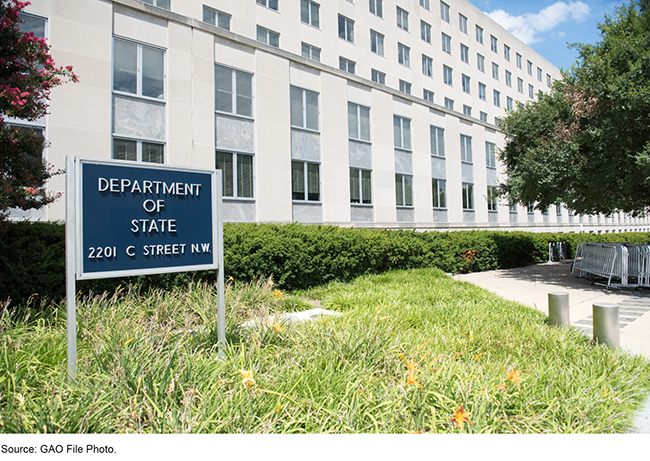State Department: Bureau of Conflict and Stabilization Operations Should Better Track Its Performance
Fast Facts
The State Department's Bureau of Conflict and Stabilization Operations works with other federal agencies and State Department offices to help prevent conflict and stabilize conflict-affected areas abroad.
We found that CSO followed some, but not all, key practices that agencies should use to measure and manage their performance. For example, CSO did not set FY 2022 targets for 8 of its 25 performance indicators, such as the number of times its instability monitoring and analysis tool is accessed.
We recommended, among other things, that CSO set targets for all indicators so that it can better assess its performance.

Highlights
What GAO Found
In recent years, the Department of State's Bureau of Conflict and Stabilization Operations (CSO) has taken a leading role in implementing laws and strategies on conflict prevention. Specifically, CSO has a new role coordinating interagency planning and implementation of a 2020 strategy to prevent conflict and stabilize conflict-affected areas abroad over 10 years. CSO officials said this strategy is a top priority for the bureau. CSO has focused its existing efforts—data analysis, staff deployments, programming, and planning—on the strategy's implementation. For example, CSO has deployed staff to help implement the strategy in priority countries.
CSO followed some, but not all, key practices that federal agencies can implement to manage their performance. CSO defined its desired outcomes but did not fully implement other practices related to measuring performance and using performance information. For example, CSO did not set fiscal year (FY) 2022 targets for eight of its 25 performance indicators, such as the number of times users viewed the Instability Monitoring and Analysis Platform. With a target for each indicator, CSO would be better positioned to fully assess its performance and identify any gaps. CSO also did not fully document its annual performance review. For example, CSO did not document how it reviewed the targets for its performance indicators in FY 2022, including its reasons for deciding not to change any of them, even those it had met. Such documentation would allow CSO to preserve knowledge of its analyses and decisions, be better positioned to act on this knowledge, and maintain consistency in its annual reviews.
Officials from State, the U.S. Agency for International Development (USAID), and the Department of Defense (DOD) identified factors that affected their collaboration with CSO. For example, 27 officials said that the expertise CSO provided to relevant efforts facilitated effective collaboration. In another example, 13 officials said that CSO's roles were not clearly defined in experiences where collaboration could have been improved. CSO requests and collects feedback on its collaboration efforts to understand the factors that facilitated or hindered collaboration. CSO collects such feedback through employee performance evaluations and surveys, among other tools.
Top Three Factors That Facilitated or Hindered Collaboration with CSO, as Identified in a Number of Interviews with State, USAID, and DOD Officials

Why GAO Did This Study
Conflict, instability, and violence continue to pose threats around the world, including to U.S. national security interests. In 2011, State established CSO to focus on conflict prevention, crisis response, and stabilization. In 2015, State's Inspector General (IG) reported that CSO had not resolved fundamental issues related to its mission, structure, and staffing that the IG had identified a year earlier.
GAO was asked to review CSO's operations. This report examines (1) how CSO's roles have changed since FY 2016, (2) the extent to which CSO followed performance management practices, and (3) relevant U.S. agencies' perspectives on CSO's collaboration efforts since 2021. GAO analyzed State data and reviewed agency documents such as strategies and policies. GAO also interviewed 29 officials from State, USAID, and DOD on their experiences collaborating with CSO.
Recommendations
GAO is making two recommendations, that State (1) require a target for each of its performance indicators and (2) fully document its performance management process, such as the annual assessments of targets and data reliability. State partially agreed with recommendation 1 and agreed with recommendation 2. GAO maintains that State should set targets for all of its performance indicators.
Recommendations for Executive Action
| Agency Affected | Recommendation | Status |
|---|---|---|
| Department of State | The Secretary of State should ensure that the Assistant Secretary for CSO requires a target for each of the bureau's performance indicators. (Recommendation 1) |
In November 2024, CSO said it has taken action to begin implementing this recommendation. When we confirm what actions CSO has taken in response to this recommendation, we will provide updated information.
|
| Department of State | The Secretary of State should ensure that the Assistant Secretary for CSO fully documents CSO's performance management process, such as steps used in the annual strategic review, including the annual assessments of targets and data reliability. (Recommendation 2) |
In November 2024, CSO said it has taken action to begin implementing this recommendation. When we confirm what actions CSO has taken in response to this recommendation, we will provide updated information.
|
